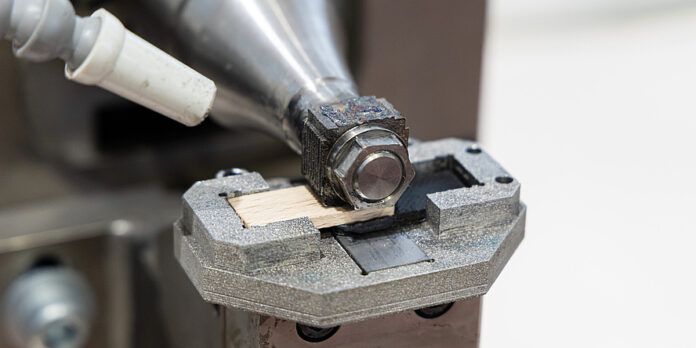Researchers at TU Graz (Gean Marcatto, Awais Awan, Willian Carvalho & Stefan Herbst) headed by Sergio Amancio have successfully tested two techniques by which strong joints can be achieved without using adhesives or screws.
Those techniques include the combination of the AddJoining technique and Additive Manufacturing. While the application of these techniques is patent-pending, it could be used in the aircraft, automotive, and furniture industries.
What does it consist of?
The research explains that with the AddJoining technique, a component made of polymer composite is affixed to and printed directly onto a surface – in this case, wood – using a 3D printing process.
The materials used extensively while testing include beech, oak, carbon fiber-reinforced polyamide and polyphenylene sulfide, and stainless steel 316L & Ti-64 alloys.
The printed elements enter the wood gaps and get into certain chemical reactions. The outcomes were promising based on mechanical load tests originally conducted on untreated wood surfaces.
AddJoining uses wood 3D printing to attach polymer composites directly to a wood surface. The release said that the material is infiltrated via wooden pores & adheres to strong chemical bonds equal to or superior to conventional adhesives.
According to a postdoc from TU Graz – Gean Marcatto, “After the joint fractured, we were able to find polymer in the wood pores and broken wood fibers in the polymer, which suggests that the fracture occurred in the wood and polymer, but not at the joint.”
He also suggests the connection between wood and polymer won’t break during mechanical tension. Laser texturing or etching can enhance bonding surfaces, but the process is designed to be simple and with decreased chemical usage.
Meanwhile, the project head Sergio Amancio explains, “Our motivation is environmental protection. But we wanted to work with as few steps as possible without chemicals. We can use this technology with complicated 3D geometries because the components are printed directly onto the surface – in whatever geometry is required.”
Ensuring a stable spot joint with ultrasonic joining
Another well-known method is ultrasonic joining. The principle involves applying high-frequency vibration to the wooden element with low amplitude with the help of sonotrode.
This creates frictional heat during the intersection between the base element (wood) and the composite material (polymer). This melts the polymer surface to flow into natural pores in the wood to make a stable & robust spot joint via mechanical interlocking & various adhesion forces.
Awais Awan of TU Graz underlines “This technique is particularly suitable for massive components & 2D structures since we achieve a precisely localized spot joint.”
In the future, the team would like to work with partners from the automotive, aircraft, and furniture industries to refine the technologies.
Author: Nagarjun M
Remember, you can post free-of-charge job opportunities in the AM Industry on 3D ADEPT Media or look for a job via our job board. Make sure to follow us on our social networks and subscribe to our weekly newsletter: Facebook, Twitter, LinkedIn & Instagram! If you want to be featured in the next issue of our digital magazine or if you hear a story that needs to be heard, make sure to send it to contact@3dadept.com.






